
Chinatown is the catch-all name for an ethnic enclave of Chinese people located outside Greater China, most often in an urban setting. Areas known as "Chinatown" exist throughout the world, including Europe, Asia, Africa, Oceania, and the Americas.
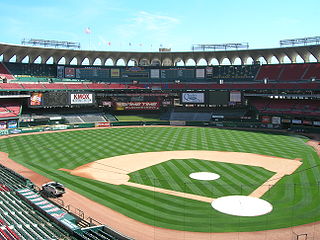
Busch Memorial Stadium was a multi-purpose sports facility in St. Louis, Missouri, that operated for 40 years, from 1966 through 2005. Built as Civic Center Busch Memorial Stadium, its official name was shortened to Busch Stadium in January 1982.

Toronto Chinatowns are ethnic enclaves in Toronto, Ontario, Canada, with a high concentration of ethnic Chinese residents and businesses. These neighbourhoods are major cultural, social and economic hubs for the Chinese-Canadian communities of the region. In addition to Toronto, several areas in the Greater Toronto Area also hold a high concentration of Chinese residents and businesses.
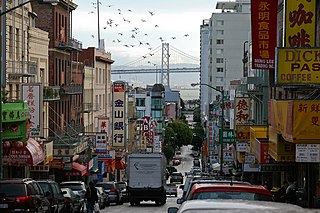
The Chinatown centered on Grant Avenue and Stockton Street in San Francisco, California, is the oldest Chinatown in North America and one of the largest Chinese enclaves outside Asia. It is also the oldest and largest of the four notable Chinese enclaves within San Francisco. Since its establishment in the early 1850s, it has been important and influential in the history and culture of ethnic Chinese immigrants in North America. Chinatown is an enclave that has retained its own customs, languages, places of worship, social clubs, and identity.
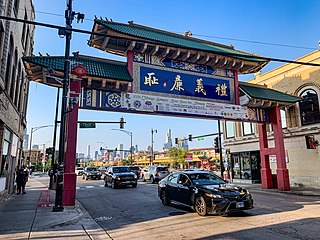
Chinatown is a neighborhood on the South Side of Chicago, along S. Wentworth Avenue between Cermak Road and W. 26th St. Over a third of Chicago's Chinese population resides in this ethnic enclave, making it one of the largest concentrations of Chinese-Americans in the United States. It formed around 1912, after settlers moved south from near the Loop, where the first enclaves were established in the 19th century.

This article discusses Chinatowns in Africa. There are at least three major Chinatowns in Africa.

Adolphus Busch was the German-born co-founder of Anheuser-Busch with his father-in-law, Eberhard Anheuser. He introduced numerous innovations, building the success of the company in the late 19th and early 20th centuries. He became a philanthropist, using some of his wealth for education and humanitarian needs. His great-great-grandson, August Busch IV, is a former CEO of Anheuser-Busch.

Busch Stadium is a baseball stadium located in St. Louis, Missouri. The stadium serves as the ballpark of Major League Baseball's St. Louis Cardinals. It has a seating capacity of 44,383, with 3,706 club seats and 61 luxury suites. It replaced Busch Memorial Stadium and occupies a portion of that stadium's former footprint. A commercial area dubbed Ballpark Village was built adjacent to the stadium over the remainder of the former stadium's footprint.

Philadelphia Chinatown is a predominantly Asian American neighborhood in Center City, Philadelphia, Pennsylvania, United States. The Philadelphia Chinatown Development Corporation supports the area. The neighborhood stretches from Vine Street on the north, Arch Street on the south; North Franklin Street and North 7th Street on the east; to North Broad Street on the west.

Mott Street is a narrow but busy thoroughfare that runs in a north–south direction in the New York City borough of Manhattan. It is regarded as Chinatown's unofficial "Main Street". Mott Street runs from Bleecker Street in the north to Chatham Square in the south. It is a one-way street with southbound-running vehicular traffic only.
The history of St. Louis began with the settlement of the area by Native American mound builders who lived as part of the Mississippian culture from the 9th century to the 15th century, followed by other migrating tribal groups. Starting in the late 17th century, French explorers arrived. Spain took over in 1763 and a trading company led by Pierre Laclede and Auguste Chouteau established the settlement of St. Louis in February 1764. It attracted French settlers leaving Illinois after their defeat in the Seven Years' War. The city grew in population due to its location as a trading post on the Mississippi River, as the western fur trade was lucrative. The city played a small role in the American Revolutionary War and became part of the U.S. through the Louisiana Purchase in 1803.
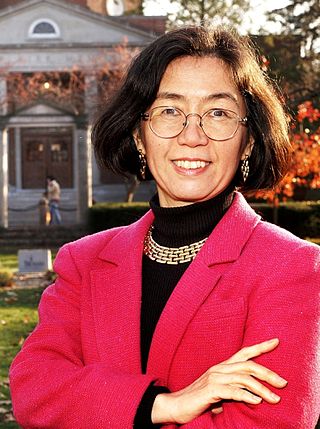
Huping Ling is a Chinese American academic. She is a professor of history and past department chair at Truman State University in Kirksville, Missouri, where she founded the Asian studies program. She is the Visiting Fellow of the Hoover Institution at Stanford University, the Changjiang Scholar Chair Professor of the Chinese Ministry of Education, Distinguished Honorary Professor at Lishui University, and a Visiting Professor of the Institute of Overseas Chinese Studies at Jinan University. She is the funding and inaugural book series editor Asian American Studies Today for Rutgers University Press, on the Editorial Board of Overseas Chinese History Study, the Overseas Chinese History Research Institution, Beijing, China, and served as the Executive Editor-in-Chief for the Journal of Asian American Studies. She is also on the Board of Directors of the Chinese Historical Society of Overseas Chinese Studies, the editorial board of Overseas Chinese History Studies, and serves as a consultant to the Overseas Chinese Affairs Office of Guangdong Provincial Government.

Chinatowns are enclaves of Chinese people outside of China. The first Chinatown in the United States was San Francisco's Chinatown in 1848, and many other Chinatowns were established in the 19th century by the Chinese diaspora on the West Coast. By 1875, Chinatowns had emerged in eastern cities such as New York City, Boston, and Philadelphia. The Chinese Exclusion Act of 1882 barred Chinese immigration to the United States, but the Magnuson Act of 1943 repealed it, and the population of Chinatowns began to rise again. In the 2010s, the downturn in the U.S. economy caused many Chinese Americans to return to China.

The San Francisco riot of 1877 was a three-day pogrom waged against Chinese immigrants in San Francisco, California by the city's majority white population from the evening of July 23 through the night of July 25, 1877. The ethnic violence which swept Chinatown resulted in four deaths and the destruction of more than $100,000 worth of property belonging to the city's Chinese immigrant population.

The U.S. city of Baltimore, Maryland is home to a small Chinatown. Historically, Baltimore had at least two districts that were called "Chinatown" where the first one existed on the 200 block of Marion Street during the 1880s. A second and current location is at the 300 block of Park Ave., which was dominated by laundries and restaurants. The initial Chinese population came because of the transcontinental railroad, however, the Chinese population never exceeded 400 as of 1941. During segregation, Chinese children were classified as "white" and went to the white schools. Chinatown was largely gone by the First World War due to urban renewal. Although Chinatown was largely spared from the riots of the 1960s, most of the Chinese residents moved to the suburbs. As of 2009, the area still shows signs of blight and does not have a Chinese arch. As of 2017, the area has become an “immigration hub” for Ethiopian people. In 2018, a mural of a Chinese dragon and an African lion was painted to signify the past as a Chinatown and the present as an African neighborhood. A night market in September 2018 marked the first Asian celebration of the area to an area that was “long forgotten and neglected”.
As of 2002, ethnic Chinese and Chinese American people comprise the second-largest Asian-origin ethnic group in the Wayne–Macomb–Oakland tri-county area in Metro Detroit. As of that year there were 16,829 ethnic Chinese, concentrated mainly in Troy, Rochester Hills, and Canton Township. As of 2012, Madison Heights also hosts a significant Chinese community.

The Chicago metropolitan area has an ethnic Chinese population. As of 2010, there are 43,228 Chinese Americans who live in Chicago, 1.6% of the city's population. This population includes native-born Chinese as well as immigrants from Mainland China, Taiwan, Hong Kong and Southeast Asia, and also racially mixed Chinese.
Greater St. Louis has a Chinese community.
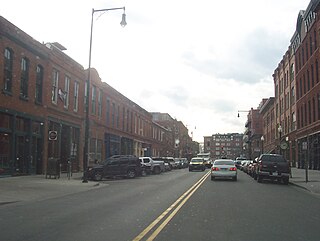
Chinatown in Denver, Colorado, was a residential and business district of Chinese Americans in what is now the LoDo section of the city. It was also referred to as "Hop Alley", based upon a slang word for opium. The first Chinese resident of Denver, Hong Lee, arrived in 1869 and lived in a shanty at Wazee and F Streets and ran a washing and ironing laundry business. More Chinese immigrants arrived in the town the following year. Men who had worked on the construction of the first transcontinental railroad or had been miners in California crossed over the Rocky Mountains after their work was completed or mines were depleted in California.
People of Chinese descent have lived in Colorado since the mid-nineteenth century, when many immigrated from China for work. Chinese immigrants have made an undeniable impact on Colorado's history and culture. While the Chinese moved throughout the state, including building small communities on the Western Slope and establishing Chinatown, Denver, the presence of Chinese Coloradans diminished significantly due to violence and discriminatory policies. As of 2018, there were 45,273 Chinese Americans living in Colorado.
















